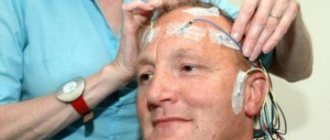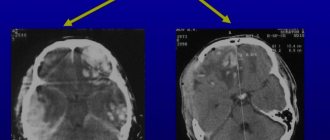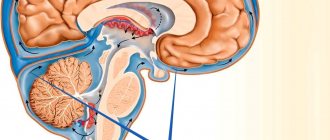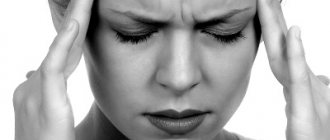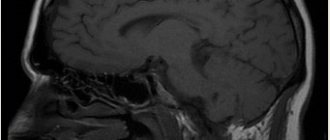This group of mental disorders includes diseases associated with short-term or permanent disturbances that occur to a person against the background of the influence of various traumatic factors on the brain.
These may be causes directly affecting the brain (trauma, neurotropic viruses, toxins), or factors associated with secondary lesions (blood or vascular diseases that lead to starvation of neurons and inhibition of their activity, endocrine diseases, brain tumors and etc.).
The causes of organic damage can be:
- Traumatic brain injuries (concussion, bruises, slaughter)
- Degenerative diseases (Alzheimer's, Pick's, Huntington's, senile dementia)
- Vascular pathology (hypertension, cerebrovascular accidents - ischemic and hemorrhagic strokes, rheumatic diseases)
- Brain tumors
- Infections (tick-borne encephalitis, syphilis, HIV, herpes virus)
- External intoxication (alcohol, drugs, toxic substances - glue, household solvents)
4.Vulnerability and protection factors
(The concept of vulnerability (exposure)
refers to the disease risk acquired during the periods of prenatal and postnatal development. Vulnerability to a disorder is the specific expression of individual and personality traits that contribute to such a disorder. Whether it will ultimately arise depends on additional triggering factors: if the vulnerability is low, more significant triggering mechanisms are required, if it is more pronounced, less significant factors are sufficient.
People who, despite having vulnerable trigger factors, do not develop the corresponding disorder are characterized as resistant.
These are, for example, children who, despite being abused, do not develop any mental disorder. Resilience is often seen as the opposite of vulnerability.)
Developmental disorders are modulated by factors that increase or decrease risk. From here we can distinguish vulnerability factors and protective
factors. To ensure that the analysis of conditions is as complete as possible, it is necessary to analyze the interaction of vulnerability factors and protective factors. Vulnerability and protective factors can be located within or outside the individual; they may further relate to different data planes: biological/somatic (genetic risk), mental (defects in the structure of perception), social (for example, insufficient social support), environmental (for example, environmental pollution).
13 pages, 6391 words
The importance of environmental stimulation for the development of functional brain systems.
... As a result of a lack of oxygen, the formation and development of the child’s brain is disrupted. It is impossible to accurately determine the cause of the disease. Risk factors are somatic and endocrine diseases of the mother... life. Sensory reactions. Motor functions. Psyche. Speech development. Third year of life. The importance of exogenous factors for the psychomotor development of a child. Preschool age (from 3 to 7 ...
Conceptually, vulnerability factors and protective factors are distinguished; however, the mutual relationships between these factors still remain unclear. There are factors that are considered both as vulnerability factors and as protective factors, depending on their sign (plus or minus).
For example, a lack of social support is considered an aggravating factor, that is, a vulnerability factor, and sufficient social support is considered a protective factor.
Organic brain damage – relationship with functional disorders
Historically, earlier in psychiatry, all mental illnesses were divided into organic (in which the substrate can be identified - the site of the lesion, the cause of the process) and functional (which are caused exclusively by social and behavioral factors).
However, with the development of medicine, this division lost its relevance and showed that exclusively organic and exclusively functional disorders are rarely encountered.
For example, post-traumatic stress disorder (PTSD) used to be considered purely functional, since its cause was the direct fact of suffering mental trauma. Now it has been proven that the emergence and development of PTSD is associated not only with the presence of mental trauma, but also with certain characterological characteristics of the individual, including those of an organic nature, the so-called. pathoplastic basis (organic lesions at the subclinical level, preceding the manifestation of PTSD, such as post-infectious processes, trauma during childbirth, etc.).
Modern instrumental studies have now proven that patients with panic disorder exhibit diencephalic insufficiency.
According to G.L. Voronkov, there are practically no organic mental disorders in their pure form; they are always a combination and interpenetration of organic and functional symptoms.
Symptoms
Organic brain diseases do not have characteristic symptoms due to their complex genesis. The following changes in behavior are recorded: activity worsens, sloppiness, problems with concentration, and apathy appear.
Old patients often forget the names of their relatives, what day or date it is, and problems with speech appear. As the disease develops, words are forgotten and the ability to maintain a conversation becomes difficult. Let's consider the types of emotional states: lack of emotions, aggressive behavior, attacks of hallucinations.
Organic brain lesions may appear during perinatal development. During the process of intrauterine development, the central nervous system has not yet become stronger, so all provoking factors can cause serious illnesses. The reasons for the transformation include: hypoxia, alcohol, psychotropic drugs, nutritional problems, chronic disorders, birth injuries, asphyxia, premature birth, infection in the newborn’s body.
If girls become pregnant at too young an age, the fetus may have difficulty developing. When a baby is born, problems in the functioning of his brain can be identified.
Sometimes situations arise when the level of brain disorder is too low; it can only be determined with the use of suitable equipment. In such cases, the disease is difficult to cure and cannot be controlled. Gradual development is observed if the disease is not detected in a timely manner.
Organic damage to part of the brain in children manifests itself in the form of migraines, sleep problems, and inability to concentrate. If left untreated, cerebral palsy, epilepsy, and neuropathy may occur.
Are some forms of organic damage to the cerebral cortex normal for age?
It is safe to say that old age is a risk factor for the development of atrophic processes in the brain and dementia. But when examining older people, it is discovered that most of them still do not have signs of this pathology. Based on this, it can be assumed that senile dementia and other organic brain lesions due to degenerative, vascular, and endocrine age-related disorders are not the age-related norm, despite the predisposition of older people to these diseases.
If we consider dementia, its clinical manifestations depend on a number of additional aspects: the causes of occurrence, premorbid personality traits (the character of a person before the disease), the social environment. Thus, a patient with certain types of dementia with a prosperous family environment, who is partially socially adapted, thanks to the support of loved ones, can function for a long time, unlike patients who are deprived of this opportunity.
Clinical signs
The main signs that indicate that a child or adult has had organic brain damage include:
- Very weak distracted attention, he has difficulty concentrating on one thing;
- Apathy - as a rule, there is no interest in anything;
- Problems with speech, it becomes slurred and inhibited, and some problems also appear with its understanding.
The table shows which clinical signs may differ depending on which area of the brain is affected:
| Region | Symptoms of the lesion |
| Frontal lobes | Mental abnormalities accompanied by irritability, aggression or, conversely, depression and apathy. Speech becomes difficult, and some phrases or sentences are misunderstood. Loss of sense of smell is common |
| Parietal region | The most obvious sign is a decrease in attention and concentration; in a child this is accompanied by poor learning at school, and in an adult, problems at work. Along with this, convulsions may appear at any time of the day. |
| Temporal lobe | The disorder is presented in the form of logoneurosis and absent-mindedness. A common symptom is partial or complete hearing loss, as well as epileptic activity. |
| Occipital region | A person has hallucinations - actions appear in his subconscious that, in fact, do not happen to him. This pathology is often accompanied by impaired vision frequency and psychiatric instability. |
More severe symptoms of the disease appear in older people. He develops memory lapses, he begins to forget important dates and the names of his loved ones. Problems of an emotional nature are also observed, presented in the form of inappropriate behavior or expression of one’s emotions.
Topography of organic damage
Thanks to the availability of modern instrumental imaging methods (computed tomography (CT), magnetic resonance imaging (MRI), positron emission tomography), it becomes possible to compare the clinical picture of an organic disorder and the localization of the lesion.
If the process involves predominantly the frontal parts of the brain, then aspontaneity (lack of impulses for motor, speech, mental and
other activities), as well as depressive symptoms. Previous attachments disappear, and behavior becomes disinhibited, moral standards are lost, anosognosia is observed - a complete lack of criticism of one’s actions. These patients may be characterized by moria syndrome, when they become complacent, euphoric, with a tendency to make inappropriate, vulgar and rude jokes, and play pranks.
If the orbital sections are affected, then impulsivity and lack of self-control may prevail - the character acquires features of psychopathic behavior.
When the temporal lobes are affected to a greater extent, memory is usually affected first, and mood may change.
When the parietal lobes are damaged, we can see first of all in the patient agnosia (loss of accumulated knowledge and the inability to acquire new ones), apraxia (loss of skills, such as drawing, sewing, professional developments), paralysis, paresis, etc.
Disturbances and changes
As a result of damage to the brain, many types of psychopathic or neurotic disorders develop. The variety of clinical manifestations is associated with the volume of the lesion and the area of the defect. The greater the depth of the destruction, the clearer the clinical manifestations. The manifestation of symptoms of the disease is also influenced by a person’s personal qualities and character. General cerebral symptoms of organic pathology are manifested by the following disorders:
- general headaches, aggravated by movement, under the influence of external stimuli (noise, bright light);
- dizziness, aggravated by movement, vestibular disorders;
- nausea and vomiting not associated with food intake;
- various autonomic disorders;
- pronounced asthenic syndrome - a state of increased fatigue, irritability, unstable mood, combined with vegetative symptoms and sleep disturbances.
Focal neurological symptoms depend on which part of the brain the pathological process develops. Table 1 identifies the regions of the brain, the functions they perform, and expected neurological signs when specific regions of the brain are affected. Table 1
| Department name | Functions | Neurological symptoms with focal lesions of the department |
| Frontal lobe |
|
|
| Parietal lobe |
|
|
| Temporal lobe |
|
|
| Occipital lobe | Perception and processing of visual information, organization of complex processes of visual perception. |
|
| Brain stem | It contains a kind of energy collector that activates the cerebral cortex. Vital centers are located: respiratory, vascular-motor, vomiting, cough, etc. The nuclei of gray matter, located in the brain stem, are related to the implementation of movements. These are important sensitive formations. |


